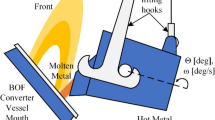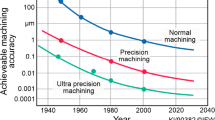Abstract
Objective
Mathematical model of an Un-Coiling Idle Coiling (UCIC) process has been used to estimate strip tension T and has combined with a controller to operate the UCIC system because T should be applied to a strip of the UCIC system to coil the strip uniformly. This paper suggests an advanced mathematical model of the UCIC process based on the previous model for winding a web to increase accuracy for estimating T.
Methods
To conduct numerical integration of structural dynamics equations; the suggested model consists of equations of motion and state variable equations. Geometrical variations including radius of the coil r, eccentricity of the coil lecc, and effective strip tension Teff with slip behavior among contact layers are renewed automatically in numerical analysis.
Simulation
The suggested model contains real operating conditions and design variables, and is calculated by Newmark's method to get dynamics responses. Moreover, planar motions are defined in the equations of the motion to check how T and dynamics responses of the un-coiler, the pinch roller, and the coiler affect each other. The planar motions have translational motions by applying spring stiffness k x and k y on the center of the rotor that correspond to elastic deformation of a bearing and a shaft.
Conclusion
Using the suggested model, T and unusual vibrations that are caused by improper coiling conditions are predicted quickly compared to a Finite Element (FE) model. Especially, Teff is similar to real T profile compared to the previous tension model when two tension models are validated with the FE model of the UCIC process.














Similar content being viewed by others
References
Choi YJ, Lee MC (2006) Study for the dowincoiler’s offline simulator. J Korean Soc Precis Eng 23:65–72
Choi YJ, Lee MC (2009) A downcoiler simulator for high performance coiling in hot strip mill lines. Int J Precis Eng Manuf 10:53–61
De Hoog FR, Cozijnsen M, Yuen WYD, Huynh HN (2004) Predicting winding stresses for wound coils of linear orthotropic material. Proc Inst Mech Eng Part C J Mech Eng Sci 218:13–25
Pholdee N, Bureerat S, Park WW, Kim DK, Im YT, Kwon HC, Chun MS (2015) Optimization of flatness of strip during coiling process based on evolutionary algorithms. Int J Precis Eng Manuf 16:1493–1499
Park YH, Park KT, Won SY, Hong WK, Park HC (2017) Stress analysis model of the strip winding system with a sleeve for a coil of thin stainless steel. J Iron Steel Res Int 24(1):1–7
Hammelmüller F, Holl HJ (2003) The effect of variable eccentricity onto the oscillations in a coiling process. PAMM 3:104–105
Irschik H, Holl HJ, Hammelmüller F (2004) Advanced dynamics and control of structures and machines. Springer, Vienna
Saad G (2000) Multivariable control of web processes, Ph.D Thesis, University of Toronto, Toronto
Lynch AF, Bortoff SA, Röbenack K (2004) Nonlinear tension observers for web machines. Automatica 40:1517–1524
Bastogne T, Noura H, Sibille P, Richard A (1998) Multivariable identification of a winding process by subspace methods for tension control. Control Eng Pract 6:1077–1088
Juvinall RC, Kurt MM (2006) Fundamentals of machine component design. John Wiley & Sons, New York
Park YH, Park KT, Won SY, Hong WK, Cheon MS, Park HC (2015) Sensitivity analysis of a winding system with unwinding-idle-winding rollers for steel plate. J MacroTrends Technol Innov 3:48–64
Čepon G, Manin L, Boltežar M (2010) Experimental identification of the contact parameters between a V-ribbed belt and a pulley. Mech Mach Theory 45:1424–1433
Zhu F, Parker RG (2005) Non-linear dynamics of a one-way clutch in belt–pulley systems. J Sound Vib 279:285–308
Singru PM, Modak JP (2005) Dynamics of arm of a flat belt drive pulley with explanation of belt flutter. J Sound Vib 279:1037–1070
Park YH, Park HC (2016) Caster with non-sinusoidal profile for use in mold oscillator. J Mech Sci Technol 30:2417–2425
Zhang XL, Liu YS, Wen BC, Zhao CY (2015) Synchronization of dual unbalanced rotors in a vibrating system with double resonant types. J Vib Eng Technol 3:769–778
Kurian VJ, Ng CY, Liew MS (2013) A Numerical and Experimental Study on motion responses of semi-submersible platforms subjected to short-crested waves. J Vib Eng Technol 3:331–344
Park YH, Park HC (2019) Variations in reaction force of the center of a sleeve depending on coiling conditions in a coiling process. J Vibration Eng Technol. accepted (JVET/CW/783) 7(2)
Author information
Authors and Affiliations
Corresponding author
Rights and permissions
About this article
Cite this article
Park, Y.H., Park, H.C. Development of a Mathematical Model of an Un-coiling Idle Coiling Process Including an Effective Tension Model for Slip Behavior Among Contact Layers. J. Vib. Eng. Technol. 6, 1–10 (2018). https://doi.org/10.1007/s42417-018-0007-6
Received:
Revised:
Accepted:
Published:
Issue Date:
DOI: https://doi.org/10.1007/s42417-018-0007-6




